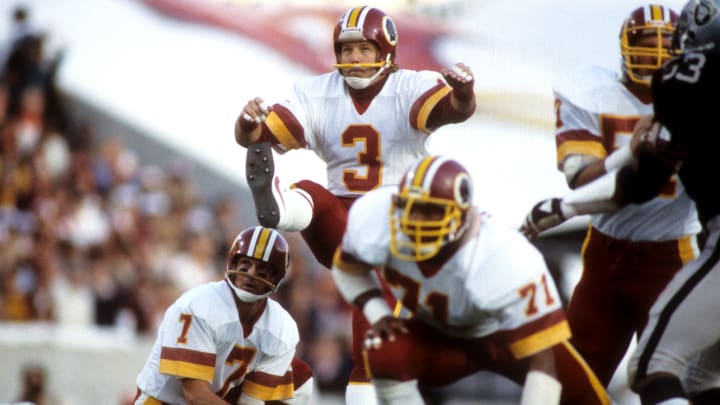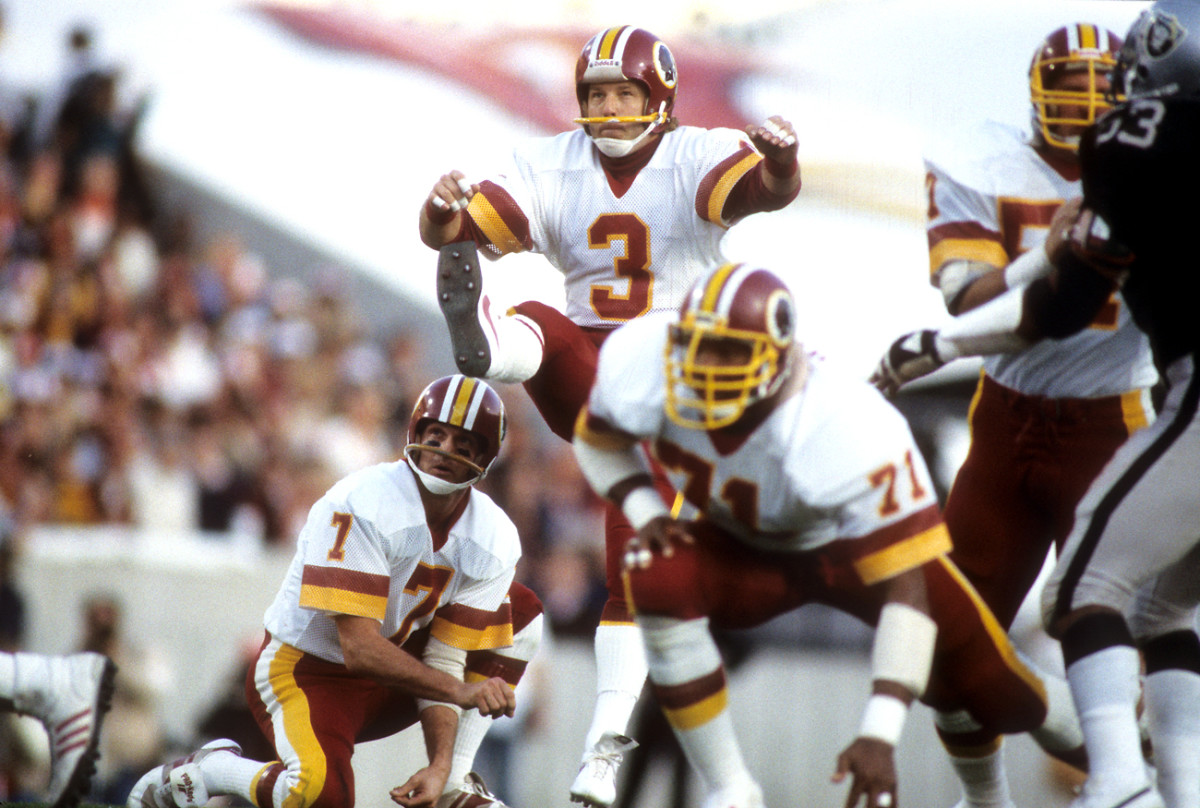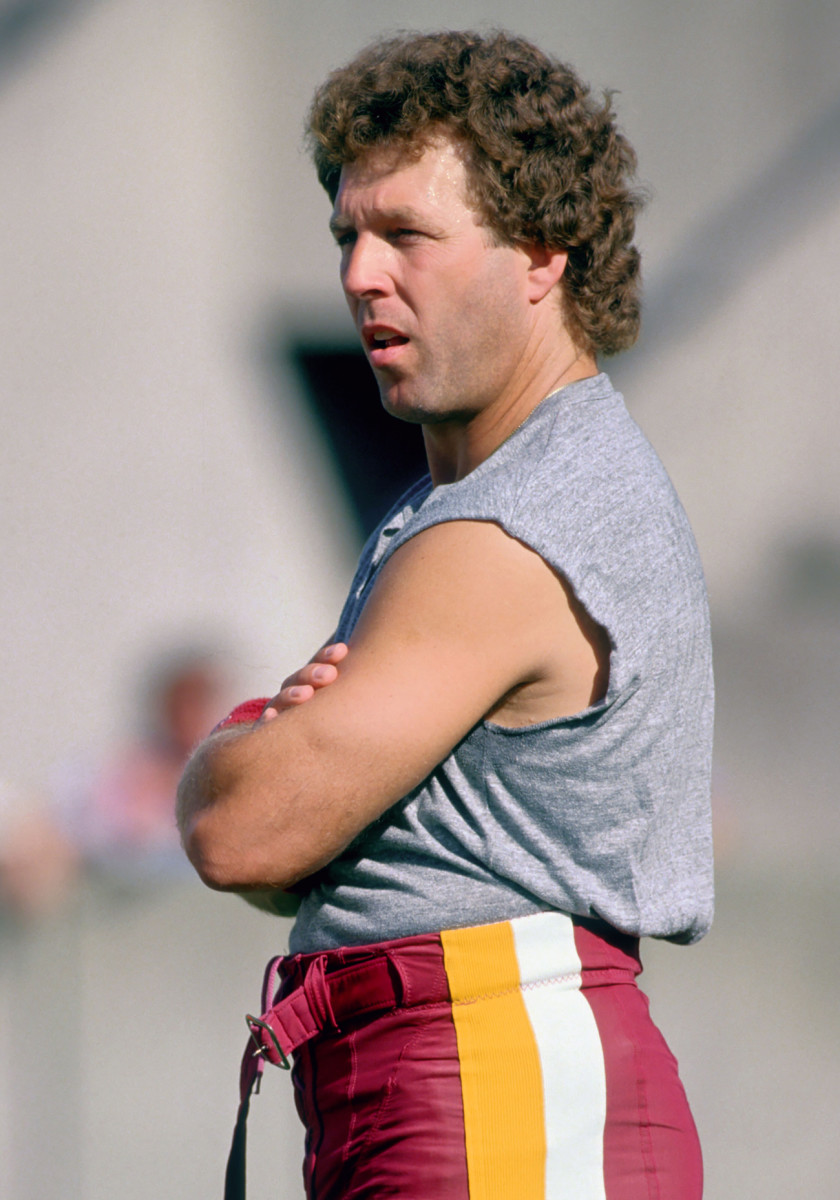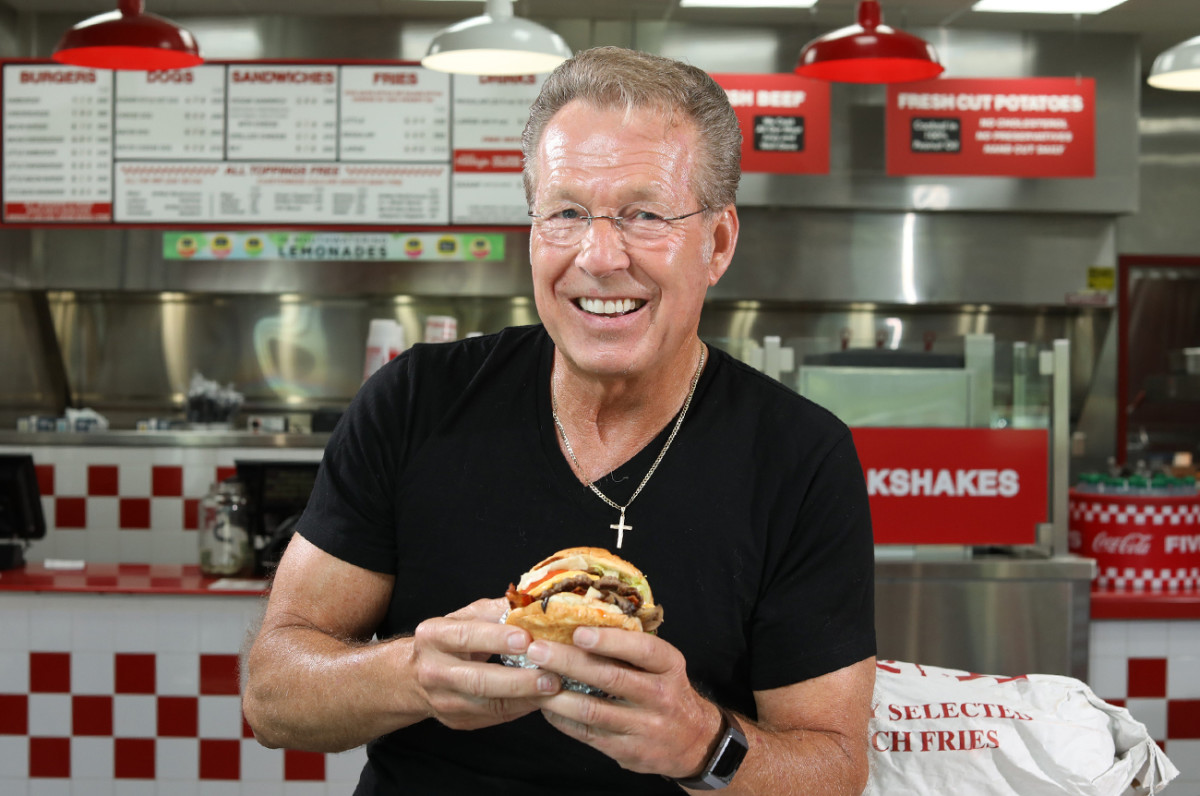Mark Moseley, Last of the Straight-On Kickers

This story appears in the July 2, 2018, issue of Sports Illustrated. For more great storytelling and in-depth analysis, subscribe to the magazine — and get up to 87 percent off the cover price plus two FREE gifts. Click here for more.
***
The end of an era rarely announces itself. No trumpets blare. No calendar pages flip. A last gasp is often as unremarked upon as it is unremarkable, creeping only later, on Sandburg’s little cat feet, into the lockbox of memory. In America’s Game, the end of an era departed on tiptoe.
September 13, 1987. The headline in Washington that Sunday was about the arrival of the Soviet foreign minister, which was expected to set the stage for a visit by Mikhail Gorbachev. Of more rooting interest, although of less global import: three-and-a-half miles east of the White House, a Redskins kicker approached a football directly, swung his right leg backward and then forward like a pendulum, struck the ball with his toes head-on and propelled it through the uprights from 40 yards out. This was the last time a straight-on kicker made an NFL field goal. Curiously, that specialist was Steve Cox, primarily a punter, who would attempt just 15 field goals in his entire career, and not Mark Moseley.
Moseley had been a member of George Allen’s Over-the-Hill Gang in the 1970s and remained a cornerstone of Joe Gibbs’s first two Washington Super Bowl teams in the subsequent decade, but when he retired after the ’86 playoffs he was with the Browns. The Skins had cut him earlier that season, his 13th in D.C., but Moseley, then 38, caught on with Cleveland in November after placekicker Matt Bahr shredded his ACL. The very last of Moseley’s 317 field goals (28th on the all-time list) would come six weeks later: a 24-yarder with 12:38 left in the AFC Championship Game against the Broncos. The significance of that kick was lost, buried in Municipal Stadium by a late Denver TD. In the end The Drive trumped Moseley’s Last Straight-On Chip Shot.
By then, America had been outsourcing kicking for two decades, hiring foreign-born workers to boot its pigskins. In stadiums across the land you could find a Garo, a Jan, a Horst or an Uwe; an Andersen with an e and an Anderson with an o. Those kickers—Yepremian (Cyprus), Stenerud (Norway), Mühlmann (Germany) and Fritsch (Austria); Morten (Denmark) and Gary (South Africa)—followed a trail blazed by the Gogolak brothers, Pete and Charlie, who fled Hungary in the wake of the 1956 revolution and then kicked in the Ivy League and later in the pros. Descriptions of the trend pioneered by the siblings were sibilant: soccer-style, sidewinder, sidesaddle. Moseley simply had been a kicker—full stop—when the Eagles drafted him in the 14th round in 1970. But by ’83, when he led the NFL with 161 points, it was Moseley who begged an adjective. The other guys were the standard. He was now a straight-on kicker or, sometimes, a toe kicker.
“For my last five years,” he says, “I was the only one in the league.”

Sidewinders had an inherent advantage, starting with the striking area. To borrow from golf: The instep of the foot is the equivalent of the modern 460cc toaster-on-a-stick compared with the old persimmon driver represented by Moseley’s three-and-a-half-inch, straight-front Nike Boomer cleat.
The kicking evolution was about physics. Sidewinders generate and direct more speed onto the ball because of angular momentum, the rotation of the hip across the axis of the torso that is the foundation of the soccer kick. “If you were going to hammer a spike, you wouldn’t just go up and down—you’d come at an angle. You’d generate more power that way,” says Bill Barfield, a former soccer coach and a professor of biomechanics at the College of Charleston and the Medical University of South Carolina. “The same is true with kicking.” Sixty years ago, when America took its whiskey and field goals straight, any kick approaching 50 yards was considered prodigious. Now 55 is the new 50. Sixty isn’t even that sexy now; it’s been achieved 13 times since 2000.
Moseley will not argue the science, although he does say, “Kicking is kicking—the goal is to get the hips pointed at the uprights.” He figures he could have succeeded either way. This is not a man plagued by doubt.
Today Moseley is a robust 70, alive if not kicking. He cuts a dashing figure in ostrich-skin boots, a blue tweed sports coat with tan elbow patches, a black T-shirt offset by a gold cross, and faded jeans with an elaborate silver-turquoise-and-amber belt buckle, presented to him by Jets defensive end Mark Gastineau, with MARK MOSELEY/3/WASHINGTON REDSKINS/KICKER etched across the front. His beard is trim, his face tan, his silvery, swept-back mane “Werewolf of London” perfect. “You won’t ever find a hair out of place,” says Joe Theismann, Moseley’s friend and once his regular holder on the Redskins. “Mark the Mannequin.”
The Greatest Team Never to Make It: An Oral History of the 1998 Vikings
For the past 13 years Moseley has lived in the Shenandoah Valley, hard by the rolling pastureland where 8,600 soldiers died at the Battle of Cedar Creek, a Union victory in October 1864. There were skirmishes on what is now Moseley’s 57-acre farm in Middletown, Va. Redskins flags flank the iron gate at the entrance. Moseley lives a quarter of a mile up a winding road in a restored barn built in 1796, all oak and cedar and flatscreens and workout machines and a vaulted ceiling better measured in hang time than feet. The barn was a makeshift hospital during the Civil War. Now it is home to a driven man who was the first employee of a stunningly successful hamburger chain; the first, only and surely last kicker ever to be named the NFL’s Most Valuable Player.
Moseley’s retirement in 1986 was the death knell for a style, and also for an era. The modern kicker is a footnote (a foot note?) because he is almost too good for glory. The heroic element of his position has vanished—except in the case of the long, last-second field goal—because of the metronomic reliability of the fitter, better-coached and more technically proficient specialists of today. A kicker is less likely to be the object of praise (seriously: MVP?!) than the target of derision, like Blair Walsh, who was run out of Minnesota after missing a 27-yarder in a 2016 playoff loss. In ’17, NFL kickers made 84.3% of their field goal attempts—a percentage that inches up invariably over time, like the national debt—including an all-time high of 69.9% from 50 yards or more. Aldrick Rosas was a shaky outlier, the first Giants kicker in a dozen years to miss at least seven attempts, but by making 18 of 25 the rookie still outpaced Moseley’s career mark of 65.6% (107th-best all time).
Fondly remembered by Washington fans as Mr. Automatic, Moseley was virtually bulletproof in his MVP year. He set what was then a single-season record of 20 consecutive field goals, before missing a 40-yarder in a meaningless finale. Moseley, admittedly, benefited from starring in a quirky season. Teams played only nine games in 1982 because of a 57-day strike, a schedule that undermined the statistical struts that buttress all MVP debates. The numbers that resonated most that autumn were Moseley’s 20 field goals and his 95.2% success rate. In that shortened season, no quarterback threw for more than 17 TDs or 3,000 yards. There were no 1,000-yard rushers. Another seven games likely would have tilted MVP voters back to the usual QB-RB candidates (the Chargers’ Dan Fouts, runner-up in MVP balloting averaged 320 passing yards per game), but Moseley’s toes were nearly perfect in an imperfect season.
“That was such an odd year that nothing surprised you,” says Theismann, who would lead the Skins to a win over the Dolphins in Super Bowl XVII that January. “But we knew we wouldn’t have been in the position we were without his field goals. We had John Riggins and Art Monk—but no question, Mark was our MVP. And he deserved to be MVP of the league.”

Moseley was born in Laneville, Texas, moved to Wyoming, then spent five years in Guayaquil, Ecuador, where his father, Jack, helped develop the country’s banana industry while working for the U.S. Agency of International Development. Mark grew up speaking as much Spanish as English. When he was in fifth grade his family returned to Texas, settling in Livingston, 75 miles north of Houston. As Jack was driving his son around their new hometown one autumn evening, Mark had his seminal Friday Night Lights moment.
“My father parked by the fence [at a high school football game],” Mark recalls. “I’d played soccer in Guayaquil, but I had no idea about this new game, so my father explained everything. Then things just stopped. Both teams left, and a band came on the field. Then a line of pretty girls came out. Then the quarterback gave a bouquet of roses to one of the girls and gave her a kiss. It was Homecoming. I guess the kissing part was what impressed me most. So I asked, ‘What do I have to do to play football?’ ”
Moseley started as a peewee running back. He would go on to play quarterback, linebacker and corner, first at Texas A&M and then at Stephen F. Austin, a solid 5' 11" 200-pounder. He would also kick, because he was better than anyone who’d been recruited to do it. He was cut after his rookie year with the Eagles (14 of 25 field goals) but caught on with the Oilers for 13 games (17 of 28) until the eternal kicking merry-go-round spun him out of football. For two years he worked as a septic-tank installer, until Allen—remembering that Moseley had made a pair of field goals for Houston in driving rain at a muddy RFK Stadium—offered him a third NFL chance, in 1974.
Can Alex Smith Turn Around Washington’s Misfortunes? Players, Coaches and Fans Are Hopeful
What Allen got was no mere specialist. Moseley was an old-time football player, and he served as the Redskins’ emergency QB, often pulling scout team duty. “Mark was never an outsider,” says defensive tackle Dave Butz, who filled in at right guard on Moseley’s field goal unit. “Some players say kickers are in a different place—but not him.”
Butz, Theismann and Moseley would ride together to RFK on game days: Butz driving his Chevy Nomad van, Moseley riding shotgun and Theismann sprawled across the bench seat in the back, perusing the game plan and copies of People and Washingtonian magazines, Butz recalls, “to see if he was in them.” Butz, meanwhile, would search for roadkill; he thought a thump-thump under his tires was an omen of good luck.
Moseley partook in a more genteel routine. On Friday nights his wife, Sharon (the second of three Mrs. Moseleys), would wash two pairs of mid-calf white socks; and on Sunday he would wear all four on his right foot, under his uniform sock. Then he would have his foot taped—two rolls’ worth—to lock the ankle in place. Lastly he’d cram this all into a size 10 1/2D white cleat that he helped design for Nike. Inside, along the vamp, two strips of leather with a piece of plastic sewn between kept the shoe rigid. The result: a boot that Butz describes as “mummified.”
“The ball came off Mark’s shoe with a pop,” says Theismann. “He wasn’t able to generate the same momentum as the sidewinders, but his power was so tremendous that with one step he was able to get that height and distance. Like a Michael Jordan jumper or a Steph Curry three-pointer: When he missed, it felt like a major spectacle.”
But misses were rare. Moseley had made his last three field goal attempts for the Redskins in 1981, and he began ’82 with three against the Eagles, including one from 26 to win in overtime. He connected on a trio the next week against the Bucs and, after the strike, hit four more against the Cardinals, all the Redskins’ points in a 12–9 victory. By Washington’s sixth game, Moseley was two shy of Yepremian’s mark: 20 straight, set over two seasons.
RFK’s dodgy surface—“painted dirt,” Theismann calls it—was a factor in almost any game, but the field was a quagmire in the snow squalls on Dec. 19 against the Giants. “Terrible field. Terrible conditions. There was so much snow you could barely make out the goalposts,” says Moseley. “In that wind, it was like trying to hit a golf ball during an earthquake.” And still he hit from 20 and 31, the second kick bringing the Redskins to within two points.
Nine seconds remained. Time for Mr. Automatic. Out of Jeff Bostic’s snap and Theismann’s hold, Moseley stepped, planted and kicked. The football skimmed off the fingers of Giants linebacker Byron Hunt, climbed, waffled, arced and clambered over the crossbar 42 yards away. Washington 15, New York 14. Record. The Redskins had qualified for the playoffs for the first time in six years, and Moseley had convinced voters that he was the most important player in that skewed season.
Two days later Moseley—who would make four of eight field goals in the playoffs but both tries in a Super Bowl win over Miami—was a guest on Good Morning America. Kickers Yepremian and later Björn Nittmo would be comedic fodder for Carson and Letterman, but Moseley was the straight news.
On a clear afternoon in Stephens City, Va., Moseley is again parked next to a football field. Six decades after his father explained the finer points of America’s Game, Mark is the one who teaches now. His truck is idling, Reba is playing on satellite radio, and Mark is watching Sherando High practice for a District 4A playoff game. His grandson Hunter Entsminger is the star quarterback. Of greater relevance, however: Mark’s protégé, Stone Garver—a hero’s name if there ever was one—is the Warriors’ kicker.
Stone is a yes-sir, no-sir senior with a deferential smile. The closest he ever came to being a kicker before 2017 was the year he dressed up as Moseley for Halloween. But then Sherando’s kicker graduated, and the team couldn’t be fussy. Entsminger lobbied coaches to check out his friend and then enlisted an old MVP as a position coach.
Michael, Murray and ... OJ? Ahmad Rashad Has Kept His Celeb Friends Close—Most of Them, Anyway
Moseley held five or six tutorials and taught some universal kicking truths: where to line up, to delay approach until the ball hits the holder’s hands, to keep your weight over your plant foot on a slick field so you don’t slip. “He wanted me to treat every kick the same, to kick an extra point like a 50-yard field goal,” says the teenager ( who kicks soccer-style, of course). “He also taught me how to keep my head. A lot of kicking is between the ears.”
Stone made all eight extra points in his first regular-season game, converting 74 of 80 on the year. He made two field goals during the regular season but missed both attempts in the playoffs as Sherando reached the division semifinals. “It’s amazing that an NFL MVP has been willing to do this for me,” he says. “Whatever he does on the side, he’s right here to help.”
About that. What Stone’s tutor does “on the side” is help run a little company called Five Guys. You might have heard of it. Moseley has been an entrepreneur since his MVP season, after which he invested his Super Bowl check into a travel business in Washington. He sold that outfit in 1998 and opened a restaurant, Moseley’s Burgers, in suburban Herndon, Va. (“Always liked burgers,” he says.) Then, in 2001, Matt Morrill, one of the Guys, stopped by Moseley’s place. They chatted and Morrill said, “You’ve really got to meet my dad.”

“[More than] 16 years later I’m still working on a handshake,” Moseley says.
The first non-family member hired by Matt’s father, Jerry, as an executive is now Five Guys’ director of franchise sales and development. Moseley has overseen the growth of a pop-and-sons shop (five locations in 2001) to one with 1,500 restaurants worldwide. He vets potential franchisees for their financial means and also for “integrity” and “character.” He even cleans tables and straightens chairs, as he did when he stopped for lunch at a Five Guys in Gainesville, Va. In the NFL his business trips took him to South Broad Street in Philadelphia and Paterson Plank Road in the New Jersey Meadowlands. Now he gets to swankier addresses: Champs-Élysées and Covent Garden, locations of Five Guys in Paris and London.
“The hardest part of field goal kicking is dealing with the pressure,” Moseley says. “But that’s true of any business. One year we projected to be short on one of our quotas. In our meetings late that year, Jerry asked if I could make it before year’s end. I told him, ‘If we close everything we’re working on, yes; but it’ll be tough sledding.’ I was still in the office with Lindsay [Entsminger, Moseley’s daughter and his administrative assistant] on New Year’s Eve, working at 10 at night.” In the end, Moseley made his number. “There was a lot of pressure meeting that goal, but it got done,” he says. “I liked the challenge. That was another Super Bowl for me.”
So let that be the lesson: With focus and diligence—and a willingness to clean tables—you can snag that last-second victory, like beating the Giants in a long-ago snowstorm. Life is all that, and a bag of fries.
Question or comment? Email us at talkback@themmqb.com.
